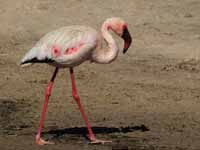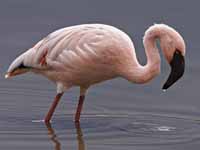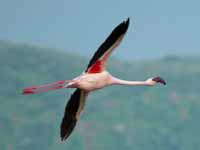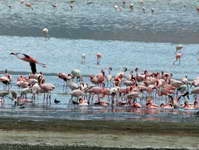THE WORLD BIRDS - An Online Bird Book
Long-Legged WADERS
Flamingos
Order Phoenicopteriformes - 1 family Family Phoenicopteridae
Long-Legged WADERS
Flamingos
Order Phoenicopteriformes - 1 family Family Phoenicopteridae
The closest flamingo relatives are a matter of debate, with current thought leaning towards the grebes. Flamingos are long legged, and very often seen resting on one leg. They tend to be of pink color, the depth of pink being a factor of diet. One of the best way to distinguish between the species is by the bill coloration. All species lay 1 chalky-white egg on a mound of mud.
Genus Phoenicoparrus
Flamingo, Andean Phoenicoparrus andinus
Description: The Andean flamingo has pink plumage, with paler underparts, a black and yellow bill, and a black rump. It has yellow legs and three-toed feet.
Range: Andean Plateau of South America.
Habitat: Wetlands, salt lakes, and salt flats.
Similar to:
* Chilean Flamingo. Andean Flamingo has a black rump. Chilean Flamingo does not have yellow on its bill.
* Jame Flamingo. Andean Flamingo has yellow legs; James Flamingo has red legs and its bill has a brighter yellow. Andean Flamingo is larger.
Conservation status:The Andean flamingo is vulnerable due to habitat degradation particularly due to the mining industry, and human disturbances such as egg poaching.
Image by: 1) Adrian Pingstone 2) Mauricio Sandoval Reyes 3) Sergey_Pisarevskiy 4, 5) Paul_Balfe - ChileRange: Andean Plateau of South America.
Habitat: Wetlands, salt lakes, and salt flats.
Similar to:
* Chilean Flamingo. Andean Flamingo has a black rump. Chilean Flamingo does not have yellow on its bill.
* Jame Flamingo. Andean Flamingo has yellow legs; James Flamingo has red legs and its bill has a brighter yellow. Andean Flamingo is larger.
Conservation status:The Andean flamingo is vulnerable due to habitat degradation particularly due to the mining industry, and human disturbances such as egg poaching.

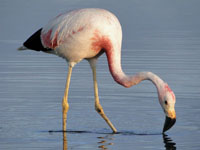


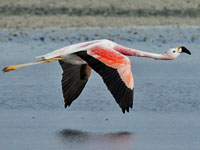
Flamingo, James Phoenicoparrus jamesi
Description: The James’s Flamingo has pale pink plumage with a black rump and carmine streaks on its back and neck. It has red orbital skin and a yellow bill with a black tip. It is similar to the Andean Flamingo but the latter has yellow legs, and the James’s flamingo has a brighter yellow bill. The Andean Flamingo is also larger. It is named after the British naturalist Harry Berkeley James.
Range: Andean Plateau of South America.
Habitat: Salt lakes and bogs.
Conservation status: James’s flamingos are near-threatened to due habitat destruction and egg poaching.
Image by: 1, 4) Luke Robinson - Chile 2) Iain and Sarah 3) David Brickman - BoliviaRange: Andean Plateau of South America.
Habitat: Salt lakes and bogs.
Conservation status: James’s flamingos are near-threatened to due habitat destruction and egg poaching.
1) Juvenile
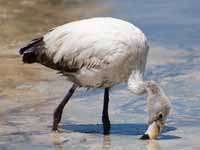
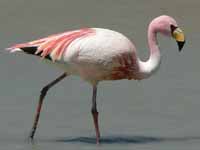
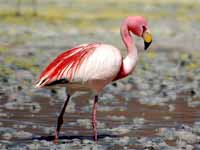

Genus Phoenicopterus
Flamingo, American also Caribbean Flamingo Phoenicopterus ruber
Description: The American flamingo has mainly pink plumage with red wing coverts. It has a pink and white bill with a black tip and pink legs. It is similar to the Chilean flamingo but the latter has more black on its bill. The American flamingo also has a deeper pink plumage.
Range: The Americas and the Galapagos Islands.
Habitat: Salt lagoons, mangroves, mudflats, and shallow brackish or salt lakes.
Conservation status: Least concern.
Image by: 1) Dick - San Diego Zoo 2) Pablo Leautard - Mexico 3) Dick Daniels - Jacksonville Zoo Range: The Americas and the Galapagos Islands.
Habitat: Salt lagoons, mangroves, mudflats, and shallow brackish or salt lakes.
Conservation status: Least concern.
4) Sandy - Flamingo Gardens - Florida 5) Sandy - San Diego Zoo 6) Dick - Galapagos Islands 7) Ferran Pestaña

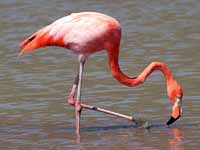
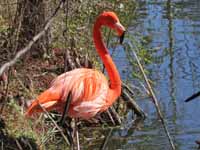

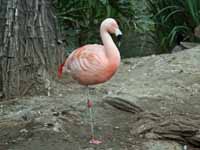
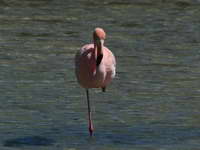
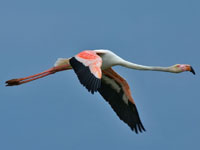
Flamingo, Chilean Phoenicopterus chilensis
Description: The Chilean flamingo has a pale pink plumage and grayish legs with pink joints. Its bill is mostly black with pinkish white at the base.
Range: They are native to South America but escaped populations have established in North America and it was also introduced to the Netherlands.
Habitat: Shallow lakes, salt lagoons, and coastal environments.
Similar to:
* American Flamingo. Chilean Flamingo has more black on its bill.
* Andean Flamingo. Andean Flamingo has a black rump. Chilean Flamingo does not have yellow on its bill.
Conservation status: The Chilean flamingo is near-threatened due to water pollution and habitat loss.
Image by: 1) NK 2) Sandy Cole - Sylvan
Heights 3, 4) Dick Daniels - Sylvan
Heights
5) Dick - North Carolina Zoo 6) Dick - The Flamingos Wildife Reserve in Las Vegas 7) Dick - San Francisco ZooRange: They are native to South America but escaped populations have established in North America and it was also introduced to the Netherlands.
Habitat: Shallow lakes, salt lagoons, and coastal environments.
Similar to:
* American Flamingo. Chilean Flamingo has more black on its bill.
* Andean Flamingo. Andean Flamingo has a black rump. Chilean Flamingo does not have yellow on its bill.
Conservation status: The Chilean flamingo is near-threatened due to water pollution and habitat loss.
2) Juvenile

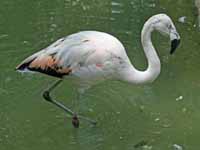
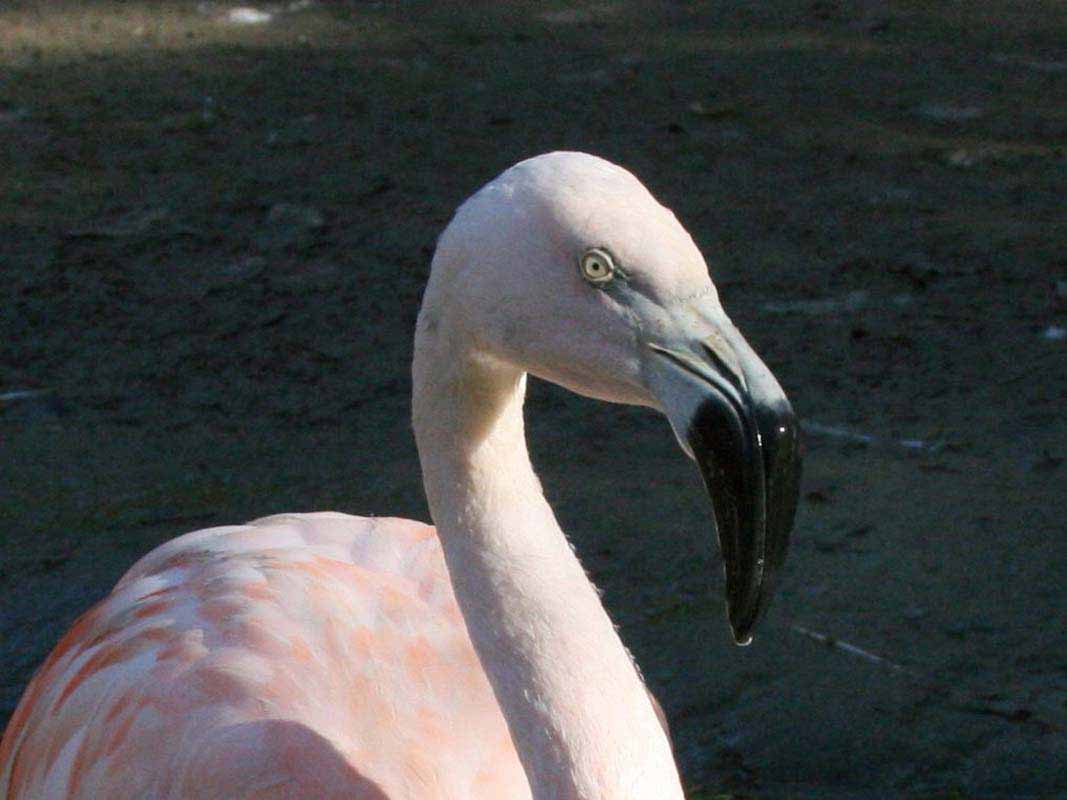
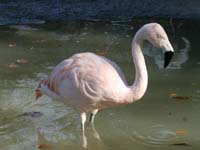
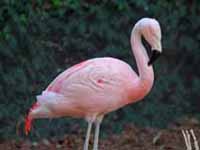
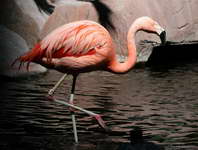
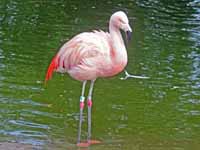
Flamingo, Greater Phoenicopterus roseus
Description: The Greater flamingo has mainly pale pink plumage with red wing coverts and black flight feathers. It has pink legs and a pink bill with a black tip. It is similar to the lesser flamingo but the latter has an all-black bill. The greater flamingo is also the largest flamingo species.
Range: They are native to Europe, Asia, and Africa. Escaped populations have established in North America.
Habitat: Mudflats and salt lagoons.
Conservation status: Least concern.
Image by: 1) William Warby - London Zoo 2) Cristiano Crolle - Walvis Bay, Namibia 3) Andrea Scaffer - France 4) Ferran Pestana - Spain 5) Aschaf - France 6) Dick Daniels - Birds of Eden, South Africa 7)
Dick - Tanzania 8) Video by Avibirds. More vidoesRange: They are native to Europe, Asia, and Africa. Escaped populations have established in North America.
Habitat: Mudflats and salt lagoons.
Conservation status: Least concern.
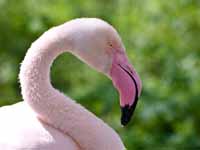
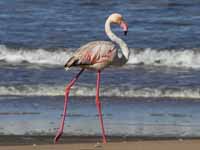


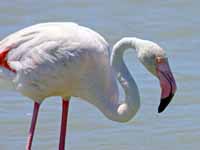

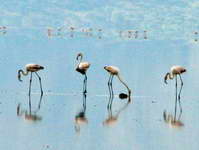
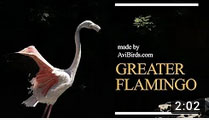
Flamingo, Lesser Phoenicopterus minor
Description: The Lesser flamingo has mainly pale pink plumage with red wing coverts and black flight feathers. It has pink legs and a black bill. It is similar to the greater flamingo but the lesser flamingo has an all-black bill and the greater flamingo is the largest flamingo species.
Range: They are native to Africa but escaped populations have established in North America.
Habitat: Inland soda lakes.
Conservation status: The lesser flamingo is near-threatened due to habitat loss, human disturbance, and water pollution.
Image by: 1) David Bygott - London Zoo 2) Cristiano Crolle - Swakopmund Namibia 3) Angell Williams - Kenya 4, 5, 9) Dick Daniels - Lake Naivasha, Kenya 6) Darren
Bellerby - Kenya 7) Jerry
Friedman -
Kenya 8) Dick - Tanzania Range: They are native to Africa but escaped populations have established in North America.
Habitat: Inland soda lakes.
Conservation status: The lesser flamingo is near-threatened due to habitat loss, human disturbance, and water pollution.

